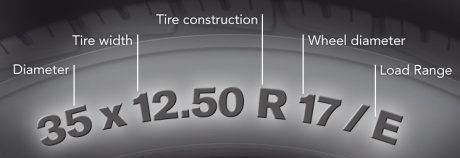
Have you ever wondered about the complex code-like numbers on the sidewall of a tire? At first glance, you might think you will need a decoder to understand all the data, or you might ignore it, thinking that the tangled combination of numbers and alphabets is useless. But let me tell you a secret, the sidewall is one of the most important things you should pay attention to. It has all the data related to tires, except the price.
All the punched figures and letters on the sidewall have a deeper meaning. Here is a quick overview to help you easily understand everything about the numbers on the sidewall.
Let’s consider an example and break it down to teach you how to read a tire sidewall.
You will find a number like P214/65R15 91T M+S near the top border of the tire. This number is giving you information about the size, width, type, and more.
Size
When you look for a tire, the primary thing you need to know is the size. To understand the perfect or suitable tire size for your vehicle, you should check the user manual or manufacturer’s website. After finding that out, you know exactly what you need. Figure P214/65R15 indicates the size code of the tire, where 91 is the load index and T is the rating for speed. Lastly, the M+S is a rating for Mud and Snow.
Type
The letter P in the size code mentioned above indicates the type of vehicle the tire can be used for. P means the passenger car, small pickup truck, or light-duty car.
Width
In size code, the following number, 214, gives you the measure of the width from sidewall to sidewall in millimeters.
Aspect Ratio
Here the number 65 represents the aspect ratio. Aspect ratio gives you the nominal heigh of the sidewall. This is calculated as a percentage of width, such as here 65 means 65% of 214mm (139.1mm).
Construction
After the Aspect Ratio, the next letters refer to the construction of the tire. Construction is mainly signified by the letter R, which means Radial construction. There are also some less popular constructions like D for Diagonal and B for Bias.
Wheel Diameter
The last number in the code gives you the diameter on which the tire will be mounted. The unit used for the diameter is an inch, and in this example, 15’’ stands for the wheel diameter.
Although knowing all this information will be enough to buy a suitable tire, there are some other codes punched on the sidewall as well. Let’s take a look at them.
DOT Code
DOT ATE9 UA40 5200 a code like this on your tire means that the tire has passed the U.S Department of Transportation’s standards of selling. The first 2 sets in code indicate the manufacturing company and their tracking code, respectively. The last 5200 tells you the week and year it was manufactured, such as 5200 means 52nd week and year 2000.
Manufacturers also have to grade their tires according to UTQG (Uniform Tire Quality Grade) shaped by DOT. In this system, the manufacturers give grades to Treadwear, Temperature Resistance, and Traction.
Same articles

Understanding Vehicle Inspection and Verification Services: Why They Matter for Every Driver
GuidesVehicle inspection and verification services are an essential but often overlooked part of keeping roads safe and cars legally compliant. Most people only think about inspections when it’s...
KLIFEX Brand Overview: High-Quality Automotive Repair Kits for Affordable Repairs
GuidesThe automotive aftermarket has long needed solutions that combine reliability, durability, and affordability. Many car enthusiasts and services are looking for a way...
Fast, Reliable Vehicle Emissions & Inspection Services Made Simple
GuidesFast, reliable emissions and inspection services are essential for keeping vehicles road-ready, compliant with environmental regulations, and safe for daily driving. If you’re looking for quick...

